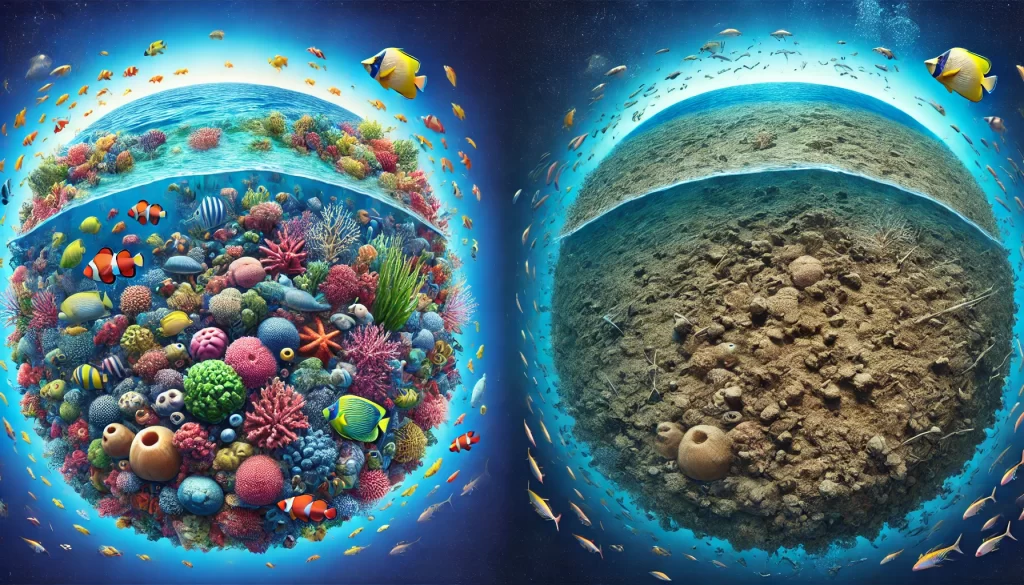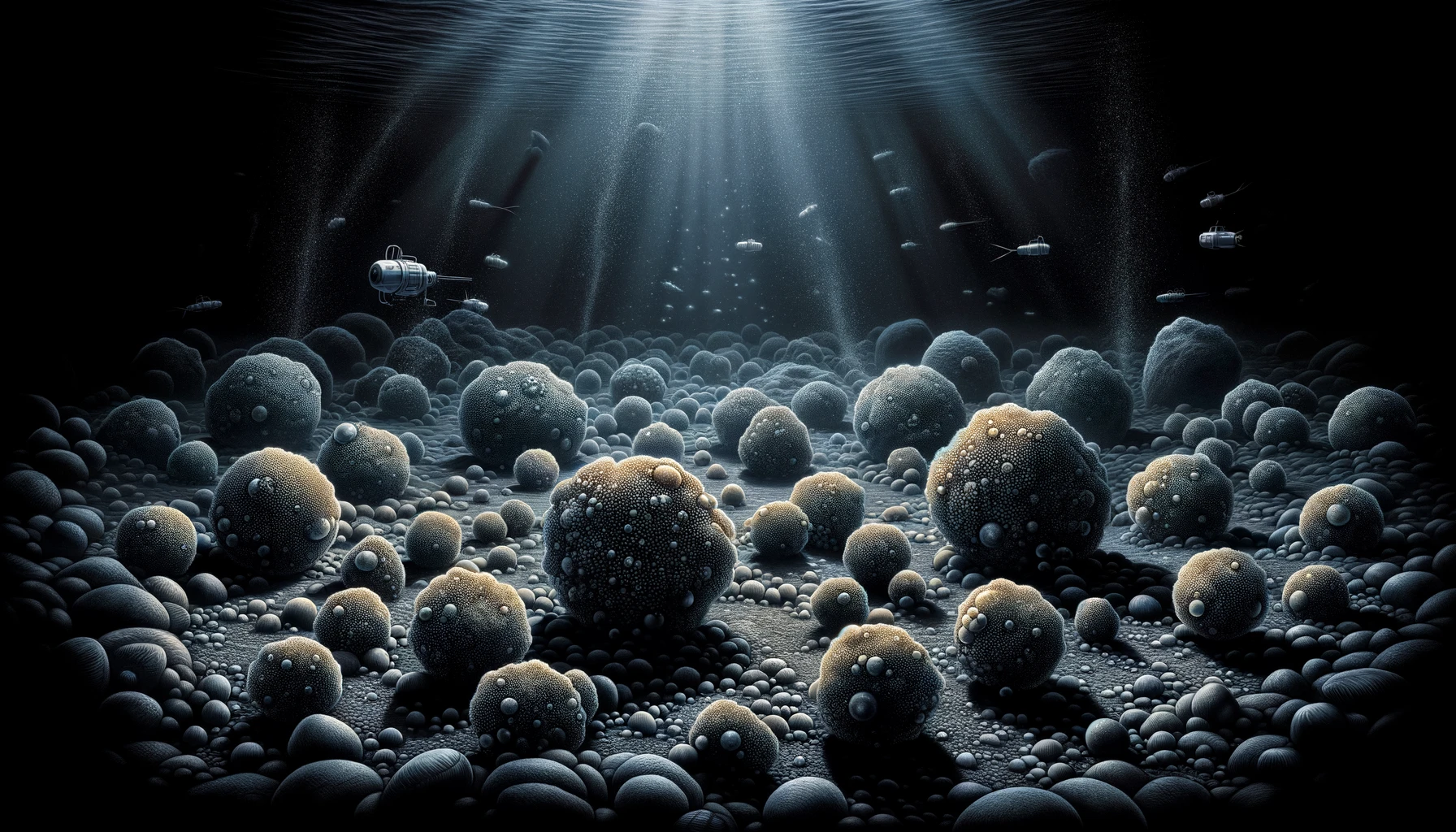Introduction
Scientists have recently discovered a surprising way that oxygen can be created in the deep ocean, challenging the long-held belief that oxygen production requires sunlight through photosynthesis. This new process involves naturally occurring metallic nodules on the ocean floor, which generate oxygen even in complete darkness.
Discovery Details
The research, led by Andrew Sweetman from the Scottish Association for Marine Science, found that polymetallic nodules, which are lumps of metals like manganese and iron, can produce oxygen through a process called seawater electrolysis. This process splits seawater into hydrogen and oxygen using the electric charge from these nodules, effectively acting like batteries.
Study Findings
Sweetman’s team discovered this phenomenon when they measured unexpected oxygen levels in the Pacific Ocean’s Clarion-Clipperton Zone. Initially, Sweetman thought the sensors were malfunctioning because the readings showed more oxygen than expected. “I basically told my students, just put the sensors back in the box. We’ll ship them back to the manufacturer and get them tested because they’re just giving us gibberish,” he said. However, after repeated tests confirmed the sensors were working correctly, the team realized they had stumbled upon something remarkable.
Bo Barker Jørgensen, a marine biogeochemistry expert, called the finding “very unusual.” He noted that this discovery could significantly impact our understanding of life’s origins on Earth and the potential for life in other dark environments. Tobias Hahn, a co-author of the study, explained, “We thought that life began on Earth when photosynthesis kicked in, as oxygen was brought to Earth through photosynthesis. It could be that actually, this process of electrochemically dividing water into oxygen and hydrogen supplied oxygen to the ocean.”

Environmental Implications
The discovery also has implications for deep-sea mining, which targets these metallic nodules for their valuable metals used in electronics and green energy technologies. Scientists, like Franz Geiger from Northwestern University, warn that mining could disrupt this newly discovered oxygen production process and harm deep-sea ecosystems that rely on it. “We need to be really careful if it turns out that deep-sea mining will become an opportunity that’s being pursued … that’s done on a level and at a frequency that is not detrimental to life down there,” Geiger told NPR.
Geiger emphasized the need for careful mining practices to avoid creating “dead zones” in the ocean, areas where marine life struggles to survive due to oxygen depletion. Historical evidence from past mining activities shows that even decades later, some mined areas have not fully recovered. “Why such ‘dead zones’ persist for decades is still unknown,” he said. But the fact that they do suggests that mining the seafloor in areas with plenty of polymetallic nodules could be especially harmful, because those areas tend to have more faunal diversity than “the most diverse tropical rainforests.”
Future Research
While this discovery is groundbreaking, many questions remain. “We just don’t know how much ‘dark oxygen’ can be created through this process, how it affects the polymetallic nodules or what quantities of nodules are needed to enable oxygen production,” Hahn said. More research is needed to fully understand the mechanisms and implications of this process.
Conclusion
This groundbreaking research reveals that oxygen can be produced in the dark, reshaping our understanding of oceanic processes and the potential impacts of human activities on deep-sea environments. As Sweetman stated, this finding is a “game changer” in our understanding of how life might have started on Earth and how we should approach deep-sea resource extraction to protect vital ocean ecosystems.
By rethinking our assumptions about oxygen production, this discovery encourages us to explore further and act responsibly to preserve our planet’s delicate and mysterious underwater worlds.
This article is based on the following articles:
https://www.washingtonpost.com/science/2024/07/23/dark-oxygen-deep-ocean-mining
https://www.bbc.com/news/articles/c728ven2v9eo
https://www.npr.org/2024/07/24/nx-s1-5049587/scientists-dark-oxygen-without-photosynthesis

Background Information
Photosynthesis and Oxygen Production
Photosynthesis is a process used by plants, algae, and some bacteria to convert light energy, usually from the sun, into chemical energy. During photosynthesis, these organisms use sunlight to turn carbon dioxide and water into glucose (a type of sugar) and oxygen. The formula for photosynthesis is often summarized as:
6CO2+6H2O+lightenergy→C6H12O6+6O2
This process is crucial because it produces oxygen, which is necessary for most life forms on Earth to breathe and survive.
Deep-Sea Environment
The deep sea is one of the least explored environments on Earth. It begins at depths of around 200 meters (656 feet) where sunlight starts to fade, extending to the ocean floor, which can be more than 6,000 meters (about 20,000 feet) deep. In these dark, cold, and high-pressure environments, life forms have adapted in extraordinary ways. Many organisms here rely on chemosynthesis, a process similar to photosynthesis but using chemical energy instead of light to produce food.
Polymetallic Nodules
Polymetallic nodules are rock-like formations found on the ocean floor, particularly in areas like the Clarion-Clipperton Zone in the Pacific Ocean. These nodules are rich in metals such as manganese, nickel, cobalt, and copper. They are of great interest for mining because these metals are essential for manufacturing batteries and other electronic devices. Polymetallic nodules form over millions of years as metals precipitate out of seawater and accumulate on small pieces of debris on the ocean floor.
Seawater Electrolysis
Electrolysis is a process that uses electricity to cause a chemical reaction, usually the splitting of molecules. In the case of seawater electrolysis, an electric current is used to split water (H2O) into hydrogen (H2) and oxygen (O2). This process requires an energy source, which, in the case of deep-sea nodules, comes from the electric charge generated by the metals within the nodules.
Deep-Sea Mining
Deep-sea mining involves extracting minerals from the ocean floor. It is a relatively new and controversial practice due to its potential environmental impacts. Mining activities can disrupt marine ecosystems, causing long-term damage to the habitats and biodiversity of the deep sea. Scientists and environmentalists are concerned that mining polymetallic nodules could destroy areas where unique life forms live and alter the ocean’s natural processes, such as the newly discovered oxygen production.
The Clarion-Clipperton Zone
The Clarion-Clipperton Zone (CCZ) is a vast area in the Pacific Ocean that spans about 6 million square kilometers (2.3 million square miles) between Hawaii and Mexico. It is one of the most mineral-rich areas of the ocean floor, known for its abundance of polymetallic nodules. The CCZ has become a focal point for potential deep-sea mining operations due to the valuable metals found there.
The Role of Oxygen in Marine Life
Oxygen is vital for most marine organisms, just as it is for land-based life. Fish, for example, extract dissolved oxygen from the water through their gills. Many microorganisms also require oxygen to survive and carry out cellular processes. In the deep ocean, oxygen levels are typically lower, and organisms have adapted to these conditions. The discovery of “dark oxygen” production adds a new dimension to our understanding of how life can thrive in these extreme environments.
Implications for Life’s Origins
The traditional view of life’s origins on Earth involves the emergence of photosynthetic organisms like cyanobacteria, which began producing oxygen around 2.5 billion years ago. This oxygenation of the atmosphere and oceans allowed for the development of complex life forms. The discovery that oxygen can be produced in the dark suggests that early life might have had an alternative oxygen source before photosynthesis became widespread, potentially reshaping our understanding of how and where life could have originated.
Please subscribe to Insight Fortnight, our biweekly newsletter!
